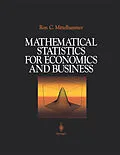A comprehensive introduction to the principles underlying statistical analyses in the fields of economics, business, and econometrics. The selection of topics is specifically designed to provide students with a substantial conceptual foundation, from which to achieve a thorough and mature understanding of statistical applications within the fields. After introducing the concepts of probability, random variables, and probability density functions, the author develops the key concepts of mathematical statistics, notably: expectation, sampling, asymptotics, and the main families of distributions. The latter half of the book is then devoted to the theories of estimation and hypothesis testing with associated examples and problems that indicate their wide applicability in economics and business. Includes hundreds of exercises and problems.
Inhalt
1. Elements of Probability Theory.- 1.1. Introduction.- 1.2. Experiment, Sample Space, Outcome, and Event.- 1.3. Nonaxiomatic Probability Definitions.- 1.4. Axiomatic Definition of Probability.- 1.5. Some Probability Theorems.- 1.6. A Digression on Events.- 1.7. Conditional Probability.- 1.8. Independence.- 1.9. Bayes's Rule.- Key Words, Phrases, and Symbols.- Problems.- 2. Random Variables, Densities, and Cumulative Distribution Functions.- 2.1. Introduction.- 2.2. Univariate Random Variables and Density Functions.- Probability Space Induced by a Random Variable.- Discrete Random Variables and Probability Density Functions.- Continuous Random Variables and Probability Density Functions.- Classes of Discrete and Continuous PDFs.- Mixed Discrete-Continuous Random Variables.- 2.3. Univariate Cumulative Distribution Functions.- CDF Properties.- Duality Between CDFs and PDFs.- 2.4. Multivariate Random Variables, PDFs, and CDFs.- Multivariate Random Variable Properties and Classes of PDFs.- Multivariate CDFs and Duality with PDFs.- Multivariate Mixed Discrete-Continuous and Composite Random Variables.- 2.5. Marginal Probability Density Functions and CDFs.- Bivariate Case.- N-Variate Case.- Marginal Cumulative Distribution Functions (MCDFs).- 2.6. Conditional Density Functions.- Bivariate Case.- Conditioning on Elementary Events in Continuous Cases.- N-Variate Case.- Conditional CDFs.- 2.7. Independence of Random Variables.- Bivariate Case.- N-Variate.- Independence Between Random Vectors and Between Functions of Random Vectors.- 2.8. Extended Example of Multivariate Concepts in the Continuous Case.- 2.9. Events Occurring with Probability Zero.- Key Words, Phrases, and Symbols.- Problems.- 3. Mathematical Expectation and Moments.- 3.1. Expectation of a Random Variable.- 3.2. Expectation of a Function of Random Variables.- Expectation Properties.- Multivariate Extensions.- 3.3. Conditional Expectation.- Regression Function.- Conditional Expectation and Regression in the Multivariate Case.- 3.4. Moments of a Random Variable.- Relationship Between Moments About the Origin and Mean.- Existence of Moments.- Nonmoment Measures of Probability Density Characteristics.- 3.5. Moment- and Cumulant-Generating Functions.- Uniqueness and Inversion of MGFs.- Cumulant-Generating Function.- Multivariate Extensions.- 3.6. Joint Moments, Covariance, and Correlation.- Covariance and Correlation.- Correlation, Linear Association, and Degeneracy.- 3.7. Means and Variances of Linear Combinations of Random Variables.- 3.8. Necessary and Sufficient Conditions for Positive Semidefiniteness.- Key Words, Phrases, and Symbols.- Problems.- 4. Parametric Families of Density Functions.- 4.1. Parametric Families of Discrete Density Functions.- Family Name: Uniform.- Family Name: Bernoulli.- Family Name: Binomial.- Family Name: Multinomial.- Family Name: Negative Binomial and Geometric.- Family Name: Poisson.- Family Name: Hypergeometric.- Family Name: Multivariate Hypergeometric.- 4.2. Parametric Families of Continuous Density Functions.- Family Name: Uniform.- Family Name: Gamma.- Gamma Subfamily Name: Exponential.- Gamma Subfamily Name: Chi-Square.- Family Name: Beta.- 4.3. The Normal Family of Densities.- Family Name: Univariate Normal.- Family Name: Multivariate Normal Density.- 4.4. The Exponential Class of Densities.- Key Words, Phrases, and Symbols.- Problems.- 5. Basic Asymptotics.- 5.1. Introduction.- 5.2. Elements of Real Analysis.- Limit of a Sequence.- Continuous Functions.- Convergence of Function Sequence.- Order of Magnitude of a Sequence.- 5.3. Types of Random-Variable Convergence.- Convergence in Distribution.- Convergence in Probability.- Convergence in Mean Square (or Convergence in Quadratic Mean).- * Almost-Sure Convergence (or Convergence with Probability 1).- Relationships Between Convergence Modes.- 5.4. Laws of Large Numbers.- Weak Laws of Large Numbers (WLLN).- *Strong Laws of Large Numbers (SLLN).- 5.5. Central Limit Theorems.- Independent Scalar Random Variables.- *Dependent Random Variables.- Multivariate Central Limit Results.- 5.6. Asymptotic Distributions of Differentiable Functions of Asymptotically Normally Distributed Random Variables.- Key Words, Phrases, and Symbols.- Problems.- 6. Sampling, Sample Moments, Sampling Distributions, and Simulation.- 6.1. Introduction.- 6.2. Random Sampling.- Random Sampling from a Population Distribution.- Random Sampling Without Replacement.- Sample Generated by a Composite Experiment.- Commonalities in Probabilistic Structure of Random Samples.- Statistics.- 6.3. Empirical or Sample Distribution Function.- EDF: Scalar Case.- EDF: Multivariate Case.- 6.4. Sample Moments and Sample Correlation.- Scalar Case.- Multivariate Case.- 6.5. Properties of X-n and S2n When Random Sampling from a Normal Distribution?.- 6.6. Sampling Distributions: Deriving Probability Densities of Functions of Random Variables.- MGF Approach.- CDF Approach.- Equivalent Events Approach (Discrete Case).- Change of Variables (Continuous Case).- 6.7. t-and F-Densities.- t-Density.- Family Name: t-Family.- F-Density.- Family Name: F-Family.- 6.8. Random Sample Simulation and the Probability Integral Transformation.- 6.9. Order Statistics.- Key Words, Phrases, and Symbols.- Problems.- 7. Elements of Point Estimation Theory.- 7.1. Introduction.- 7.2. Statistical Models.- 7.3. Estimators and Estimator Properties.- Estimators.- Estimator Properties.- Finite Sample Properties.- Asymptotic Properties.- Class of Consistent Asymptotically Normal (CAN) Estimators and Asymptotic Properties.- 7.4. Sufficient Statistics.- Minimal Sufficient Statistics.- Sufficient Statistics in the Exponential Class.- Sufficiency and the MSE Criterion.- Complete Sufficient Statistics.- Sufficiency, Minimality, and Completeness of Functions of Sufficient Statistics.- 7.5. Results on MVUE Estimation.- Cramér-Rao Lower Bound.- Complete Sufficient Statistics and MVUEs.- Key Words, Phrases, and Symbols.- Problems.- 8. Point Estimation Methods.- 8.1. Introduction.- 8.2. Least Squares and the General Linear Model.- The Classical GLM Assumptions.- Estimator for ? Under Classical GLM Assumptions.- Estimator for ?2 Under Classical GLM Assumptions.- Consistency of ?^.- Consistency of ?2.- Asymptotic Normality of ?^.- Asymptotic Normality of ?2.- Summary of Estimator Properties.- Violations of Classic GLM Assumptions.- GLM Assumption Violations: Property Summary and Epilogue.- Least Squares Under Normality.- MVUE Property of ?^ and ?2.- 8.3. The Method of Maximum Likelihood.- MLE Mechanics.- MLE Properties: Finite Sample.- MLE Properties: Large Sample.- MLE Invariance Principle.- MLE Property Summary.- 8.4. The Method of Moments.- Method of Moments Estimator.- MOM Estimator Properties.- Generalized Method of Moments (GMM) sEstimator.- GMM Properties.- Key Words, Phrases, and Symbols.- Problems.- 9. Elements of Hypothesis-Testing Theory.- 9.1. Introduction.- 9.2. Statistical Hypotheses.- 9.3. Basic Hypothesis-Testing Concepts.- Statistical Hypothesis Tests.- Type I Error, Type II Error, and Ideal Statistical Tests.- Contro…
